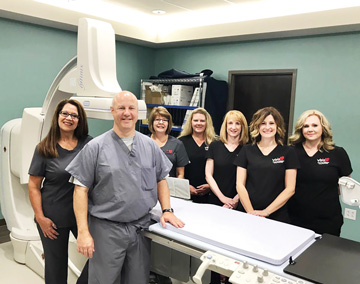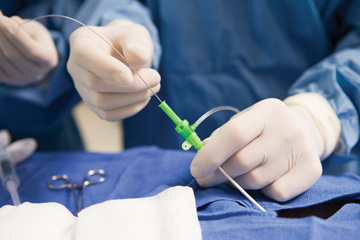Make Trusted Connections and Keep Them
Leaders sometimes become isolated in their roles as they face a seemingly never-ending wave of daily obstacles and long-term challenges....
This website uses cookies. to enhance your browsing experience, serve personalized ads or content, and analyze our traffic. By clicking “Accept & Close”, you consent to our use of cookies. Read our Privacy Policy to learn more.
By: Joe Paone | Senior Editor
Published: 9/13/2021
The catherization lab built in the new Quincy Medical Group (QMG) Surgery Center is the first of its kind in Illinois and showcases the tantalizing potential of outpatient cardiac care. Physician owners of the multispecialty ASC say adding
the cath lab is a significant step forward in providing patients with convenient and cost-effective access to procedures that detect blockages in coronary arteries.
QMG cardiologist Wissam Derian, MD, FACC, CCDS, says cardiac
catheterization has evolved to the point that patients can often safely have the procedure and go home the same day. During the procedure, a thin flexible tube is inserted into the arteries of the patient’s heart, and dye is injected
to visualize blockages.
The procedure has traditionally been performed from the large artery in the leg. Over the last several years, however, cardiologists have started utilizing the radial artery in the wrist. “In about 90% of the cases, we have begun using access in the wrist instead of the groin area,” says Dr. Derian. “This reduces the risk of complications and the length of stay for the patient.” Patients at this facility are ready to return home about two hours after a diagnostic cardiac catheterization.
That’s not the only cardiac procedure QMG Surgery Center will perform. The physician owners have plans to add left and right diagnostic and interventional heart catheterization; pacemaker and ICD generator exchanges; loop recorder insertion and extraction; and transesophageal echocardiogram with cardioversion. Patients will be carefully screened to ensure the procedures are appropriate for the outpatient setting.
“Patient safety is our number one priority,” says Dr. Derian. “There is much research that goes into any approved procedure, and we will always follow appropriate guidelines for any procedure performed in our facility.”
Patients are referred internally to the cath lab by the practices of QMG physicians. Ted Johnson, director of cardiac services at QMG, says the cath lab within its ASC adheres to state and national regulations. “Our cardiologists have led the way from start to finish — from patient eligibility and selection to equipment, policy and protocol development, competency tools, emergency preparedness and staffing selection,” says Mr. Johnson.

The migration of cardiology procedures toward outpatient facilities is being mitigated by various regulatory and business factors. One recent monkey wrench for leaders in this movement is a suddenly vacillating CMS.
The Medicare payer added several cardiac diagnostic and intervention ASC codes in 2019 and 2020, and hundreds more for 2021. That, combined with CMS’ statement that it would eliminate the inpatient-only list entirely in 2024, provided a strong indication that the migration of cases was at full speed. This summer, however, CMS’ proposed 2022 ASC payment rule didn’t include almost all of the cardiac ASC codes that were new to the list this year. The 2019 and 2020 codes are safe for now.
The reversal in payment policy is not yet set in stone. CMS is accepting open comments on the proposed rule until Sept. 17, and will announce the final rule in November. The final rule will take effect Jan. 1, 2022.
For its part, the Ambulatory Surgery Center Association (ASCA) is polling its membership about the potential impact of CMS’ proposed action. “We’re asking our members who do cardiac cases whether they’ve started performing the procedures on Medicare patients,” says ASCA CEO Bill Prentice.
Eric Dippel, MD, FACC, FSCAI, founder and president of Vascular Institute of the Midwest in Davenport, Iowa, notes that the reversal came after the massive political changes in Washington this winter, along with the fact that hospitals have lost significant amounts of money during the pandemic and are looking to CMS for help in recouping lost revenues. While that’s a tribute to the powerful hospital lobby, he views CMS’ proposed payment rule as a temporary Band-Aid for hospitals.
“The long and the short of it is that hospitals ultimately are going to lose this battle,” says Dr. Dippel. “Physicians will continue to leave the hospital environment, and provide better, more patient-friendly care at a lower cost than can be done in a hospital.”
Facilities like Quincy (Ill.) Medical Group (QMG) Surgery Center are understandably taking a wait-and-see approach to the shifting payment landscape while providing the best patient care they can. “We’re always looking to grow and expand our care services that we can offer to meet the ever-changing needs of our patients in the lowest cost-of-care setting available,” says QMG Director of Cardiac Services Ted Johnson. “CMS is continuing to change and evolve, and our care will continue to change and evolve with it.”
— Joe Paone

QMG knows the opportunity to provide cardiac care in outpatient facilities offers a wealth of promise for physicians and patients. Efforts to move more cases to surgery centers continue, but are being tempered by regulatory requirements, powerful hospital lobbyists and questions surrounding Medicare reimbursements (see “CMS Changes Stance on ASC Codes”).
There are two types of outpatient facilities that deal with matters of the heart and vascular system: ASCs and office-based labs (OBLs). Currently, they are two different types of sites of service as defined by CMS, largely performing different types of procedures. The desire to combine cardiac ASCs with OBLs to provide comprehensive outpatient cardiology services makes practical sense for many facility leaders and physicians, and is enticing for patients who want to avoid having relatively simple procedures performed in hospitals — especially during COVID-19.
If only it were that simple, however. The obstacles to adding outpatient cardiac cases can be daunting, depending on the state in which you’re operating. Eric Dippel, MD, FACC, FSCAI, founder and president of Vascular Institute of the Midwest in Davenport, Iowa, estimates there are around 900 OBLs across the country. Many of them, like his, are “mom and pop” operations, owned by physicians and not part of large local healthcare or hospital systems.
Dr. Dippel, an interventional cardiologist frustrated with the inefficiencies and bureaucracy of the hospital system at which he had worked, founded his OBL in 2016. He performs coronary and peripheral vascular angioplasty and stenting, superficial endovenous procedures, pacemaker placements and diagnostic imaging and testing. Because of regulatory limitations, however, he’s focused mostly on peripheral vascular work at his facility.
“Every state has their own regulations,” says Dr. Dippel. “Iowa is a certificate of need (CON) state.” CONs are state regulatory mechanisms for establishing or expanding healthcare facilities and services in a specific geographic area. The idealism behind CON laws is to control healthcare costs by restricting duplicative services in communities. The reality, says Dr. Dippel, is the laws effectively quash many independent facilities from reaching their full potential, or even getting off the ground in the first place. “In Iowa, you must apply for a CON to open an ASC,” he adds. “Local regulations are difficult to overcome as an individual provider.”
What’s more, Dr. Dippel says he’d actually need to apply for two CONs — one to establish an ASC and another to perform coronary interventions. In each case, he would need to argue his case to a panel of physicians and other health providers as to why these services are needed in the local community. “If I tried to do that, the hospitals in town would oppose me,” he says. “It would be an uphill battle.”
Dr. Dippel notes that not all states require CONs before new healthcare projects are launched. In states that don’t have CON laws, it’s much easier to open an ASC where physicians perform procedures such as coronary angiograms and transesophageal echocardiograms, as well as place stents, pacemakers and loop recorders. “There’s talk around the country of getting rid of the CON requirements in some states,” says Dr. Dippel, “because it’s an antiquated, inefficient system.”
Even if a CON is obtained, Dr. Dippel notes, an existing OBL and a new ASC located in the same building must be separate business entities — and that’s just the beginning of the upgrades required. “There are more regulations to navigate when opening an ASC than there are when opening an OBL,” he says.
CMS doesn’t allow billing under two different places of service at the same time from the same address, explains Dr. Dippel. He says cardiology practices must create hybrid facilities, which he explains with this example: “Monday, Tuesday and Wednesday, they run it as an OBL. Thursday and Friday, they run it as an ASC.”
Dr. Dippel is confident that despite regulatory and other roadblocks, the exodus of cardiology procedures to outpatient facilities is essentially unstoppable over time. “As more vascular procedures are done in the ambulatory setting, the natural progression is that coronary procedures will follow,” he says. “The landscape is definitely evolving, and will continue to evolve.”
For now, Dr. Dippel’s work is focused on the blood vessels outside the heart. “I do a lot of limb salvage procedures,” he says. “I get a lot of referrals from wound clinics for patients who have non-healing ulcers. I put stents in diabetic patients’ legs to improve circulation so they can avoid amputations.”
In his view, patients and physicians will drive the outpatient migration. “Patients love our facility,” says Dr. Dippel. “They pull up, walk in and we take care of them right away. Patient satisfaction scores are higher in the outpatient setting and the quality of care is much better.” OSM
Leaders sometimes become isolated in their roles as they face a seemingly never-ending wave of daily obstacles and long-term challenges....
Have you or your team done something amazing at your facility or for your patients that you’d like to crow about? Would you like to achieve industry recognition for your...
As a stress management speaker, I espouse concepts such as...